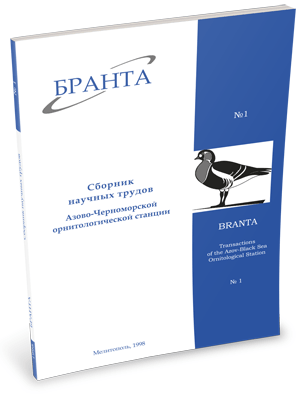
Transactions
of the Azov-Black Sea Ornithological Station



Territorial links of Sand Martin in the South of Ukraine
Chemichko R.N.
There are several conflicting points of view on the breeding site fidelity and phylopatry of birds. Some researchers think, that all birds return to the breeding sites or areas, where they were bom. Thus, they suppose existence of local populations. In this case all individuals, which did not return are considered to be dead (Исаков, 1949; Поливанов, 1957). Others object existence of such
local populations and suppose that populations constantly mix due to the dispersion and immigration within large areas (Мальчевский, 1968, 1969, 1974).
Our study of Sand Martin (Riparia riparia) territoriality was carried out in a control settlement on Yuzhni Bug river (Fig. I). The size of this settlement fluctuated annually from 1101 to 1724 individuals (Table 1). The initial data for analysis are presented in Table 2. The results of the calculations are found in tables 4,5,7-9. These data allow to give qualitative and quantitative characteristics of the settlement (Table 11, Fig. 2).
One colony in the settlement, which played a forming role, existed throughout the study period. It was populated earlier than others and had the highest reproduction success. This colony was always the largest, share of local birds in it varied between years from 9.3 to 37% out of the total numbers in the whole settlement, whereas in other colonies it never increased more than to
1.7-5.3% (Table 11). In our case it was colony 2, which was called dominant colony. Others were called sub dominant colonies. In the years unfavourable for the dominant colony (destruction of the precipice, diseases, predation or direct destruction of the colony by man) these were only the sub dominant colonies, which played a major role in maintaining local population.
In whole, the results obtained allow to state that on one hand, breeding site fidelity and phylopatry, and on the other hand, dispersion (emigration and immigration) are closely related aspects of evolution. As biological processes they are opposite by the effect: conservatism saves the microevolutionary achievements of the species, whereas dispersion gives opportunities for new
achievements. Facilitating isolation of population, conservatism allows to use advantages accumulating "local” experience. Dispersion, which makes obstacles for the isolation, increases ecological plasticity of the species owing to interpopulaion exchange. Balance of the two processes ensures stable existence of the species.
Read the paper in a PDF file